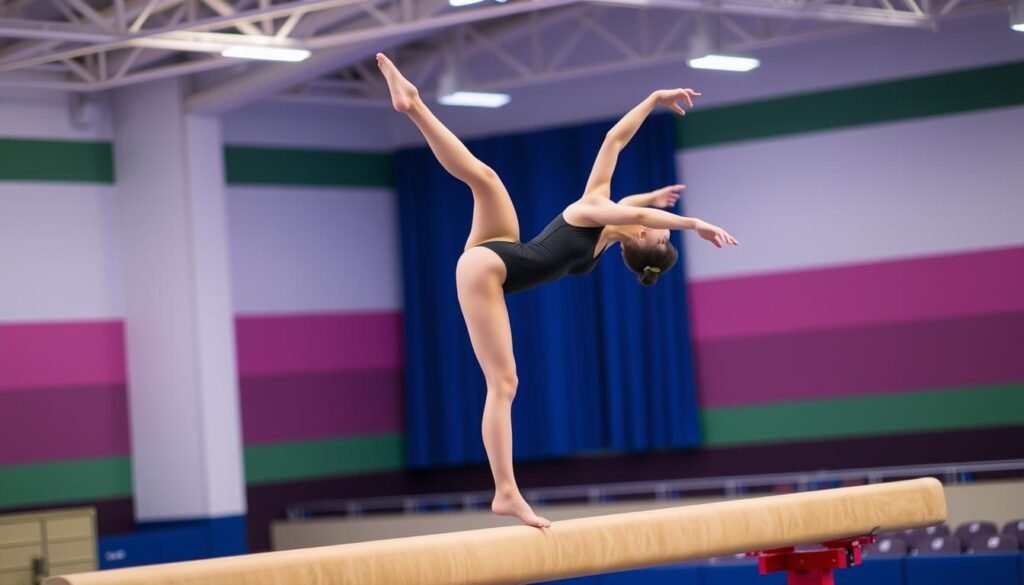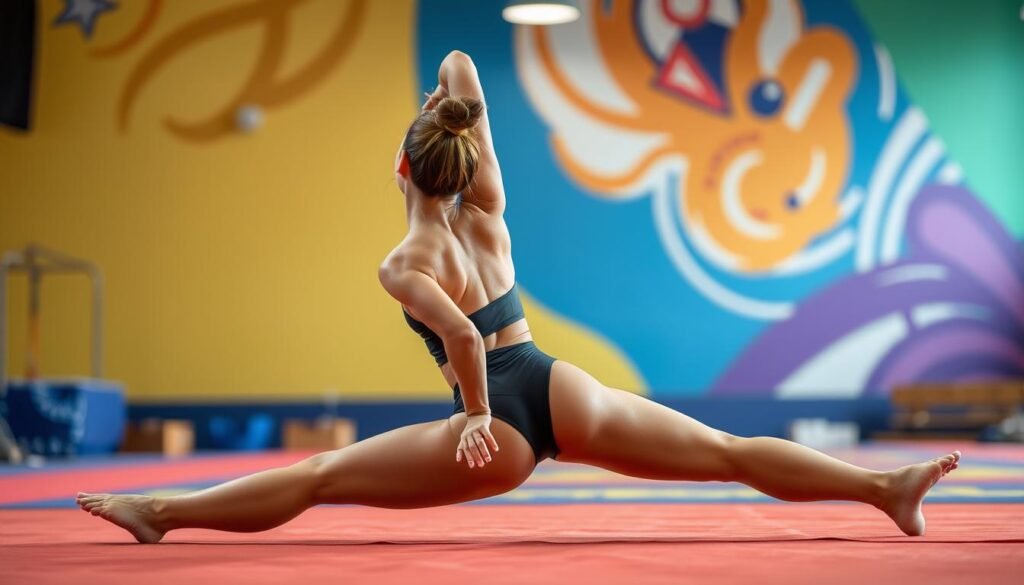At 15, Sophia watched the New York Times feature on “Flexible Gymnastics Move” with excitement and fear. She was amazed by the gymnasts’ incredible flexibility. Sophia had always loved gymnastics, but this was different. It showed the hard work and skill of elite gymnasts.
After seeing the article, Sophia decided to try it herself. She started a tough training plan, adding flexibility exercises to her day. It wasn’t simple, but Sophia’s love for gymnastics kept her going. She quickly noticed her flexibility and gymnastics skills improving.
As Sophia got more flexible, she loved the beauty of these moves. The training made her stronger and more focused. With each success, Sophia felt more confident. She knew mastering this move would change her life.
The Art of Flexible Gymnastics Moves
In the world of gymnastics, flexibility is key. It makes performances stand out and wins over fans. Gymnasts’ flexibility, from splits to backbends, shows what the human body can do.
Why Flexibility is the Unsung Hero of Gymnastics
Flexibility is the base of gymnasts’ amazing routines. Without it, their fluid moves and complex skills wouldn’t be possible. Judges give higher scores for routines that show off gymnasts’ flexibility.
Understanding the “Flexible Gymnastics Move NYT”
A “flexible gymnastics move” needs a lot of flexibility in muscles and joints. These include splits, backbends, and extreme contortion. Gymnasts with great flexibility do better in competitions. Their moves impress the crowd and show their skill and control.
| Flexible Gymnastics Moves | Description |
|---|---|
| Splits | A basic move where legs are straight and split in a line to the floor, forward, sideways, or mixed. |
| Backbends | This move bends the spine back, often leading to a bridge or handstand. |
| Needle Scales | A tough move where gymnasts balance on one leg, raising the other straight up, forming a “needle” shape. |
| Ring Jumps | An acrobatic move where gymnasts jump and tuck their legs into a ring shape, showing great flexibility and control. |
| Oversplits | An advanced move where legs are split more than 180 degrees, needing lots of flexibility and strength. |

To master these flexible gymnastics moves, gymnasts need hard work, regular training, and a focus on flexibility. By improving their flexibility, gymnasts can make their routines better, impress the audience, and get ahead in gymnastics.
Mastering the flexible gymnastics move nyt
Achieving excellence in gymnastics is all about finding the right mix of strength and flexibility. At the core of this balance is the skill of flexible gymnastics moves. This skill pushes the limits of human agility. It requires not just physical strength but also a deep grasp of dynamic flexibility and how strength and suppleness work together.
Stretching Beyond Limits with Dynamic Flexibility
Dynamic flexibility is key in flexible gymnastics moves. It lets gymnasts stretch further and do more impressive athletic feats. Unlike static flexibility, which is about holding still, dynamic flexibility is about moving and stretching. Gymnasts use dynamic flexibility exercises to boost their agility, increase their range of motion, and get ready for their sport’s demands.
The Balance Between Strength and Flexibility
For gymnasts aiming to master flexible gymnastics moves, finding the right balance between strength and flexibility is crucial. Flexibility allows for more movement, while strength is needed to control and execute those movements. Strength training helps support muscles and joints during tough routines. It builds a strong base for gymnasts to do complex moves with elegance and power.
| Key Aspects of Mastering Flexible Gymnastics Moves | Description |
|---|---|
| Dynamic Flexibility | Active movements that allow gymnasts to stretch further and execute more impressive feats of athleticism |
| Strength Training | Exercises that build core strength, stability, and endurance to support flexible gymnastics moves |
| Synergy Between Strength and Flexibility | The perfect balance between power and range of motion, enabling gymnasts to perform with control and precision |
By using dynamic flexibility and finding a balance between strength and flexibility, gymnasts can reach their full potential. They can improve their performance and amaze audiences with their amazing agility and control.

Conclusion
Flexible gymnastics moves are key to gymnasts’ success. They allow for amazing routines filled with grace and precision. Flexibility is vital in training for gymnasts who want to shine. It opens up new possibilities in their performances, boosting both skill and creativity.
For those interested in gymnastics, exploring flexibility training is a great start. It reveals the beauty and artistry of mastering contortion and extreme flexibility. Through conditioning and workout routines, anyone can improve their flexibility and master gymnastics moves.
Recent studies show that extreme flexibility isn’t always needed. A balanced approach to strength and flexibility works well for gymnasts. Embracing flexible gymnastics moves lets athletes and fans alike explore new heights of performance and self-expression. It inspires awe and wonder globally.